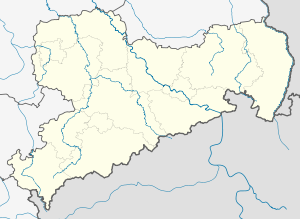Hirschfelde power plant
| Hirschfelde power plant | |||
|---|---|---|---|
| location | |||
|
|
|||
| Coordinates | 50 ° 56 '15 " N , 14 ° 53' 29" E | ||
| country | Germany | ||
| Data | |||
| Type | coal-fired power station | ||
| Primary energy | Fossil energy | ||
| fuel | Brown coal ( Lusatian brown coal area ) | ||
| power | Max. 330 MW (electric) (1961) | ||
| Start of operations | 1911 | ||
| Shutdown | 1992 | ||
| Website | www.kraftwerk-hirschfelde.de | ||
The former Hirschfelde power station is an industrial monument and former museum in East Saxony. It belonged to the Upper Lusatian mining district .
location
It is located in the Hirschfelde district of Zittau in the district of Görlitz on the federal highway 99 between Zittau and Görlitz , right on the border with Poland .
history
The technical monument and museum is the preserved part of the oldest large Saxon power plant , in which electrical energy was continuously generated from 1911 to 1992 . The total energy generated amounted to 71,300,000 MWh. The largest amount of energy was achieved in 1961 with 2,037,800 MWh.
The maximum installed capacity was 330 MW in 1960 . Coal consumption was 172 million tons. “Machine 5” achieved the longest operating time with 413,499 operating hours and was in operation from 1929 to 1992. The "Dampfkessel 21" was in operation from 1921 to 1982 and achieved 410,252 operating hours. The power plant employed around 5,000 people in four generations, including Felix Gulich, who was employed at the power plant from 1920 to 1981 and, at 61 years of age, had the longest service with the company.
In the GDR , coal from the nearby Polish open-cast mine Turów was converted into electricity here under the name Peace Border Power Plant until 1982 . After the People's Republic of Poland stopped the supply of coal, instead of coal deposits in eastern Germany (been open pit Olbersdorf , open pit Berzdorf , Niederlausitz ) burned. Since the Polish side also subsequently refused to accept the ashes that had been returned up to then, a rinsing dump was built about three kilometers from the power plant in Wittgendorf . The ash mixed with water was pumped to this location via pipes and dumped. The seepage water was fed to the Neisse. In Poland, on the other hand, the Turów power plant was built and continues to exist.
The power plant was shut down in 1992 by the operator at the time, VEAG , for economic reasons. In the same year, the machine house II with its technical systems and the administration building were placed under monument protection.
Since the shutdown, the “Technical Monument & Museum Kraftwerk Hirschfelde” e. V., in which predominantly former employees of the power plant volunteered, for the maintenance of the museum, which presents a unique industrial architecture, power plant technology and an overview of the electrical energy mechanical engineering.
The legal successor of VEAG, Vattenfall Europe , had launched a foundation initiative to preserve it. The foundation is now the Technical Monument and Museum Kraftwerk Hirschfelde Foundation. Due to the dilapidation of the machine house, the power plant museum had to be closed in June 2017. The association disbanded at the end of 2017. The power station foundation is busy handing over the exhibits to other museums or collections. At the end of June 2018, the machine house is to be returned to the owner, Lausitz Energie Bergbau AG. After that, termination is planned.
The Hirschfelde Power Plant Foundation is now dedicated to digital archiving and monument preservation , as well as initiating projects that are intended to contribute to the further development of Lusatia .
Web links
- Official website
- Jan Lange: Farewell to the power plant. In: Saxon newspaper . December 29, 2017, accessed April 13, 2020 .
Individual evidence
- ↑ https://www.ehrenamt.sachsen.de/engagementboerse/verein/3802
- ^ Johannes Staemmler, Jana Priemer, Julia Gabler: Civil society in structural change. Associations and foundations in Lusatia . Ed .: Institute for Transformative Sustainability ResearchInstitute for Transformative Sustainability Research / Institute for Advanced Sustainability Studies e. V. IASS. Potsdam June 2020, p. 12 , doi : 10.2312 / iass.2020.023 .




